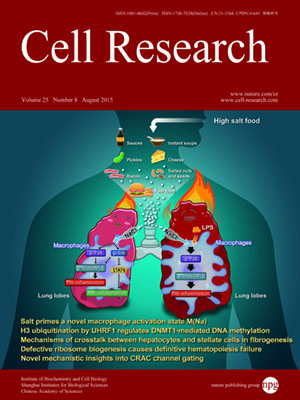
Volume 25, No 8, Aug 2015
ISSN: 1001-0602
EISSN: 1748-7838 2018
impact factor 17.848*
(Clarivate Analytics, 2019)
Volume 25 Issue 8, August 2015: 963-980
ORIGINAL ARTICLES
Critical role for Orai1 C-terminal domain and TM4 in CRAC channel gating
Raz Palty1, Cherise Stanley1 and Ehud Y Isacoff1,2,3
1Department of Molecular and Cell Biology, University of California Berkeley, Berkeley, CA 94720, USA
2Helen Wills Neuroscience Institute, University of California Berkeley, Berkeley, CA 94720, USA
3Physical Bioscience Division, Lawrence Berkeley National Laboratory, Berkeley, CA 94720, USA
Correspondence: Ehud Y Isacoff, Tel: +510-642-9853;(ehud@berkeley.edu)
Calcium flux through store-operated calcium entry is a major regulator of intracellular calcium homeostasis and various calcium signaling pathways. Two key components of the store-operated calcium release-activated calcium channel are the Ca2+-sensing protein stromal interaction molecule 1 (STIM1) and the channel pore-forming protein Orai1. Following calcium depletion from the endoplasmic reticulum, STIM1 undergoes conformational changes that unmask an Orai1-activating domain called CAD. CAD binds to two sites in Orai1, one in the N terminal and one in the C terminal. Most previous studies suggested that gating is initiated by STIM1 binding at the Orai1 N-terminal site, just proximal to the TM1 pore-lining segment, and that binding at the C terminal simply anchors STIM1 within reach of the N terminal. However, a recent study had challenged this view and suggested that the Orai1 C-terminal region is more than a simple STIM1-anchoring site. In this study, we establish that the Orai1 C-terminal domain plays a direct role in gating. We identify a linker region between TM4 and the C-terminal STIM1-binding segment of Orai1 as a key determinant that couples STIM1 binding to gating. We further find that Proline 245 in TM4 of Orai1 is essential for stabilizing the closed state of the channel. Taken together with previous studies, our results suggest a dual-trigger mechanism of Orai1 activation in which binding of STIM1 at the N- and C-terminal domains of Orai1 induces rearrangements in proximal membrane segments to open the channel.
10.1038/cr.2015.80
FULL TEXT | PDF
Browse 2030


